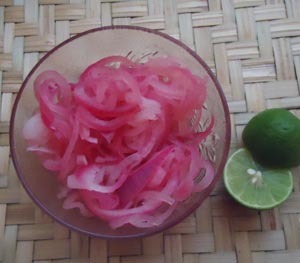It seems that so often when I cook something savory, I automatically reach for an onion. Even when undecided about what else might go in a dish, there is a good chance that it will call for some form of Allium cepa, or cultivated onion. With the exception of desserts (and even here, I’ve recently read about a sweet onion pie) onions are used in countless culinary creations and in most of the world’s cuisines. Their unique taste is part of several essential flavor bases in Latin American and European cooking, among others.

Soups, stocks and broths, stews, sauces and a multitude of other aromatic preparations often rely on onions for seasoning. Onions can be boiled, baked, sautéed, roasted, deep fried, or grilled. They can be caramelized or sweated before adding to other foods, and they can be used raw in salads or as garnishes.
In Mexican food, onions are almost always used in meat and poultry broths, which are essential for making moles, pipians and a huge variety of guisados, or stews. (Mexicans watching foreigners cook have observed that “so much” onion is being used, and I think this is because there are so many wonderful herbs and spices in Mexican cooking, that onions are used more judiciously.)
The white variety is the onion of choice in classic Mexican cooking. They have a clean, sharp taste and are more tender and thin skinned than other varieties. Use them in both raw and cooked salsas, and grill them with peppers when making fajitas. Sautéing them brings out a sweet flavor.
Also popular in Mexico is the red onion, or as it is more properly called in Spanish, cebolla morada, or purple onion. This variety is indispensable in the cuisine of the Yucatan, where cebollas encurtidas, or pickled onions, accompany cochinita pibil and other signature dishes of the region. Their mild flavor and attractive color make them a natural for salads. They are also good for grilling, roasting and broiling.
Green onions, which are simply the young shoots of bulb onions, are milder tasting than larger onions. Called cebollita or cebolla cambray, they are a requisite component of any Mexican parillada, or meal of grilled food, whether beef, chicken, chorizos, or a mix of meat, poultry or vegetables. They are also used in salads and as garnishes. Green onions have a small, white bulb that has not fully developed and long, green stalks, with both parts being edible. Scallions are less mature than green onions, having no discernible bulb, and are not commonly found in Mexican mercados except very large or gourmet venues such as Mexico City’s Mercado San Juan.
Yellow onions are not as common or desirable in Mexico as the red, white and green, though they are sometimes found in the large chain supermarkets. Leeks, on the other hand, are found in most markets and supermarkets. Called poros in Mexico, they are often used in soups and stews, as well as being braised and served as a vegetable side dish. While not technically an onion, the leek is a fellow member of the Allium genus and shares several characteristics with the onion.
The shallot, on the other hand, is a bona fide member of Allium cepa, nearly always found in Mexican supermarkets and at specialty produce stalls at larger municipal mercados. The chive, called cebollin, is the smallest species of edible onion and, like shallots, is only found in supermarkets and a few market stalls.
Most food historians agree that the onion has been cultivated for over 5,000 years, though both Asia and the Middle East have been suggested as places of origin. They have been pictured in ancient Egyptian art and even discovered in the body cavities of mummies. The first century Roman author and naturalist Pliny the elder wrote of onions curing vision problems, dysentery and a host of other ailments, including insomnia.
By the time the Europeans brought onions to the New World, they were one of the three main vegetables of European cooking, along with beans and cabbage. Strains of wild onions did grow throughout the Americas, though bearing little resemblance to the onions used in Mexican cooking today.
In addition to their culinary versatility, onions — despite the tears they sometimes cause — are remarkably effective in fighting illness. While the health benefits described by Pliny the Elder have never been proven, we do know that the phytochemicals in onions potentiate vitamin C absorption and help regulate blood sugar. A compound called quercitin, found in onions, plays a role in preventing cancer, and the tops of green onions are rich in Vitamin A. Onions are a good source of fiber and are free of sodium, fat and cholesterol.
When buying onions, look for firm bulbs with little to no scent, and avoid any with cuts or bruises. Store them in a cool dark, dry place with plenty of air circulation. In the case of green onions, look for crisp, bright green stalks and firm bulbs. Remove any rubber bands or, in the case of some mercados, palm leaf ties that hold them together. Strip away any wilted stalks and keep refrigerated for up to five days. Once cut, onions can be stored, refrigerated, in a sealed container for up to a week.
When using white onions to flavor broth for mole, stick a whole clove into each onion half being used, to bring out the aromatic characteristics of the onion. Stuff white onions with meat or vegetables for a main or side dish. Do as the Mexicans do and add some green onions to the grill the next time you grill meat or poultry. Marinate red onions Mexican style, and you’ll find them almost indispensable in sandwich making or as a side salad with roasted meat or chicken.
Try the following recipes to add a characteristically tasty Mexican touch to any meal.
- Onions stuffed with Mexican chorizo and potatoes: Cebollas rellenas con chorizo y papas
- Mexican grilled green onions: Cebollitas a la parilla
- Yucatan style pickled onions: Cebollas encurtidas estilo yucateca


